If you’ve won, inherited or saved £10,000, you might reasonably wonder where is the best place to put it.
Of course, there’s no one simple answer as to how best to invest £10,000, as it depends on your personal circumstances – such as how much of the money you can afford to lose and when you expect to withdraw it – as well as on market conditions.
Do you want to add steadily to your savings over the long term, or are you looking for a quick return? And do you want to beat inflation so that your investment grows in real terms, despite the rising cost of living?
The more you hope to return, the greater the level of risk you are likely to face and the longer you will need to set your money aside.
So with all of those factors in mind, here’s how best to invest £10k for a variety of personal circumstances – and remember always to check the current markets and make your own decision, as conditions change all the time.
Choose your risk level
Before you put your money anywhere, decide how much risk you’re willing to take on. This often depends primarily on how much of your money you can afford to lose, and you should never speculate with money that you need to pay essential bills and living costs.
Some of the options include:
- Cash ISAs and savings accounts with a fixed interest rate.
- Long-term savings accounts that lock your money away for a year or more.
- Stocks and shares ISAs that can both gain and lose value over time.
- Funds such as ETFs that track a relatively broad sector or economy.
- Pension funds that lock your money away until you retire.
You can see the kind of spectrum that is available. Some options do not put your initial investment at any likely risk – even if your bank collapses, cash savings accounts are usually protected by the Financial Services Compensation Scheme.
In other cases, your initial deposit might be locked away for a specified period of time, and you could lose some of your capital gains if you make an early withdrawal. On most stock market products, your initial deposit is at risk if your stocks and shares fall in price, too.
The level of risk you take on is very personal. It can depend on factors like how much other savings or regular income you have, how close you are to retirement, and how much value you want to gain on your investments.
However, you don’t have to invest all of your money into one account – you could instead spread it around, with some in high-yield but high-risk investments and the rest adding value more steadily in a conventional savings account.
Tax-efficient savings
Tax is a big factor in deciding where best to invest £10k. There are a variety of tax-efficient savings accounts available, such as the Lifetime ISA, which comes with a 25% bonus contribution from the government.
Again, the exact types of bonus ISAs and the amounts available change regularly, so always check what’s currently on the market.
But these can be a good option for younger people. They’re often designed to help with saving towards a deposit on your first home, or for the longer term as tax-free retirement savings.
Remember that with an ISA, you get a new tax-free allowance each financial year. So if you’ve already made substantial deposits this year, it might be worth splitting your £10,000 into a couple of payments.
This way, you can use up any remaining allowance before April 6th while making sure the rest of your money goes in after the new tax year starts so you don’t get taxed on it either.
High earners
If you earn more than the higher rate threshold for tax (£50,000 in recent years) you might benefit more from the tax relief available on a Self Investment Personal Pension, or SIPP.
You usually cannot access the money in your SIPP until you reach the minimum retirement age, which is ten years before the state pension age.
So be aware that if you put your full £10,000 into a SIPP in your 20s or 30s, you could be looking at up to about 40 years before you can get at that money again.
But also remember that this is the point of pensions. They are a lifetime savings account designed to grow in value throughout your career, before paying out enough during your retirement to sustain the lifestyle you’re accustomed to.
Higher risk investments
To outpace the rate of inflation, historically your best bet has always been to speculate on the stock market.
At a younger age, you’re better placed to take this risk, as if you lose money on your investments you can leave them to recover for longer and regain a profit.
Diversification can spread this risk across different sectors and global economies. Tracker Funds and Exchange Traded Funds (ETFs) allow you to buy into a basket of stocks and receive capital growth in line with the relevant index or market.
Some investors choose to go it alone, buying specific stocks and shares they believe are poised for growth.
This is even higher risk, especially if you plan to focus on companies you expect to grow in value massively in a very short period of time.
However, the pay-off can be significant if you get it right. Just be careful you don’t risk money you can’t afford to lose, as these stocks are more likely to fail as well.
Investing in a trend
If you want to keep your investment portfolio interesting on a personal level, consider investing in a trend or topic that’s close to your heart.
This might not yield the most added value, compared with just going where the money is, but it can allow you to buy into funds that you are passionate about.
Obvious examples right now include ethical, sustainable and environmentally responsible funds, those with a focus on human rights, or those that support small businesses.
Many of these funds post relatively strong positive growth and as consumers continue to back trends with a positive impact, that could translate into more growth in the years to come.
Be wary of brand new investments with no proven historical performance – they’re not always bad, but it’s harder to be confident about the promised returns.
And watch out for bubbles, such as the dotcom bubble around the Millennium, which cost many investors dearly as they went all-in on a booming digital market that proved to be unsustainable.
Set goals
Finally, know what your end goals are. In a pension, for example, you might want to aim for a specific total fund size or to achieve a certain annuity or annual income after retirement.
In shorter-term savings accounts, you might want to save enough for a large purchase, such as using an ISA to save a house deposit or to buy a new car.
At the end of the day, it’s your money to spend on enjoying your life as you wish. If you’re happier spending it on holidays, make sure you can withdraw up to a few thousand per year.
If you’re starting a family, consider saving for when your child reaches the age of 18, as any financial help you give them at that point can be worth so much more over the rest of their lifetime.
Or if you’re nearing retirement, look at ways to maximise your savings over the last few years of your career. Even late in life, £10,000 can yield good value in the short term, without taking on an unacceptable amount of risk.
And don’t be afraid to spend. Inheritance tax will eat away a substantial chunk of any legacy you leave anyway – so enjoy yourself. You’ve earned it.
Disclaimer: The information provided here is not investment, tax or financial advice. You should consult with a licensed professional for advice concerning your specific situation.




